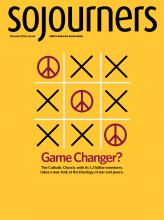“JUST WAR IS KILLING US! There is no just war.”
That proclamation by a Catholic sister from Iraq, and others like it, resounded at a Vatican gathering this spring and fell on surprisingly receptive ears.
Sister Nazik Matty, an Iraqi Dominican, joined others from around the world in Rome in April to wrestle with how the Catholic Church could “recommit to the centrality of gospel nonviolence.” She has watched members of her religious community die for lack of medical care during war.
“Which of the wars we have been in is a just war?” asked Sister Matty, who was driven from her home in Mosul by ISIS, also known by the Arabic acronym Daesh. “In my country, there was no just war. War is the mother of ignorance, isolation, and poverty. Please tell the world there is no such thing as a just war. I say this as a daughter of war.”
The Rome gathering on Nonviolence and Just Peace was unprecedented, bringing together members of the church hierarchy with social scientists, theologians, practitioners of nonviolence, diplomats, and unarmed civilian peacekeepers to discuss Catholic nonviolence and whether in the contemporary world armed force can ever be justified.
Of course, with such diverse participants, there was not a common mind on whether just war theory, a doctrine of military ethics used by Catholic theologians, has outlived its usefulness as church teaching.
Some of the academics and diplomats—particularly from the United States and Western Europe—maintained that just war criteria, when properly applied, are useful when working within halls of power, from the Pentagon to the United Nations, for restraining excessive use of military force by a state. One participant cautioned against “broad condemnations of just war tradition, if it means closing off dialogue with our allies.” Another questioned how diplomacy could continue without the just war framework as its common language.
But Catholics who came to Rome from conflict zones—Afghanistan, Iraq, Pakistan, Palestine, Colombia, Mexico, the Democratic Republic of Congo, Burundi, and Uganda—brought a different perspective.
Read the Full Article

